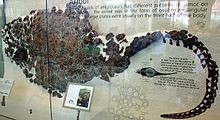蜥结龙属
| 蜥结龙属 化石时期:白垩纪前期,
| |
|---|---|

| |
| 蜥结龙的复原图 | |
| 科学分类 | |
| 界: | 动物界 Animalia |
| 门: | 脊索动物门 Chordata |
| 纲: | 蜥形纲 Sauropsida |
| 总目: | 恐龙总目 Dinosauria |
| 目: | †鸟臀目 Ornithischia |
| 科: | †结节龙科 Nodosauridae |
| 属: | †蜥结龙属 Sauropelta Ostrom, 1970 |
| 模式种 | |
| 爱氏蜥结龙 Sauropelta edwardsorum Ostrom, 1970
| |
蜥结龙属(属名:Sauropelta,意为“蜥蜴的甲盾”)又名楯甲龙,是结节龙科恐龙的一属,生存于早白垩纪的北美洲。目前已有一个已命名种,爱氏蜥结龙(S. edwardsorum),但可能有其他种存在。就生理结构上而言,蜥结龙是研究最深入的结节龙科之一;大部分化石发现于Cloverly组地层,约1亿1500万年前到1亿1000万年前。
蜥结龙是种中等大小的结节龙科恐龙,身长约5米。蜥结龙拥有特别长的尾巴,占了身长的一半。虽然蜥结龙的身体小于现代的黑犀牛,但体型相近,而重量估计约1500公斤。这些额外的重量主要来自于身体外部的骨板,包含颈部的大型尖刺。
叙述

蜥结龙是种四足、草食性恐龙,身长接近5米[1]。头颅骨呈三角形,口鼻部逐渐变尖,后段较宽,眼睛后面最宽处为35公分[2]。不像某些其他结节龙科,蜥结龙的头顶平坦,而非圆顶状。蜥结龙的头顶非常厚,由平坦的骨质骨板所覆盖,因为这些骨板紧紧地固定住,所以没有胄甲龙、爪爪龙、林木龙、与其他甲龙类所拥有的颅缝。这状态有可能是化石保存过程的后果。如同其他甲龙类,蜥结龙的眶后骨与颧骨有三角形的厚鳞甲,分别位于眼睛之上与之下[2]。蜥结龙的上下颌拥有叶状牙齿,可用来切断植物,这是典型的结节龙科特征。目前不清楚头颅骨的前端模样,但上下颌前端应有锐利的骨质啮喙(Tomium),如同其他甲龙类。这些啮喙可能覆盖者角质,构成喙状嘴[3]。
蜥结龙的尾巴相当长,占了身体长度的接近一半。一个化石上发现了40节尾椎,但某些已经遗失,所以实际数目应该超过50节。尾巴拥有骨化肌腱,可使尾巴硬挺。如同其他甲龙类,蜥结龙拥有宽广的身体、非常宽的骨盆与胸腔。前肢短于后肢,使得背部呈弓状,最高处位于臀部。牠们的足部、四肢、肩膀、骨盆非常结实,可支撑巨大的体重。美国古生物学家肯尼思·卡彭特(Kenneth Carpenter)估计蜥结龙的体重为1500公斤[1]。

如同其他结节龙科,蜥结龙身上覆盖者装甲,由嵌入皮肤的皮内成骨(Osteoderm)所构成。这些鳞甲都位于牠们生前的位置,使得肯尼思·卡彭特与其他科学家可以精确的描述它们的位置。蜥结龙的颈部有两排平行的鳞甲,背部与尾巴的上半面皮肤覆盖者小型、骨质棱甲,而身体左右两侧各有一排平行的大型、圆锥状鳞甲。臀部上方的小棱甲与大型圆形鳞甲互相紧密交错,形成荐部装甲[1]。这种荐部装甲也发现于其他甲龙类身上,例如多刺甲龙与南极甲龙[3][4]。蜥结龙的身体两侧各有两排大型的尖刺,尖刺从颈部开始,越接近肩膀的尖刺越大,身体两侧的尖刺逐渐缩小,终止在臀部。臀部之后的尾巴两侧则有平坦的三角形骨板,骨板朝后方,而且越接近尾端,骨板越小。肯尼思·卡彭特最初认为蜥结龙的身体的两侧各有一排颈部尖刺与尾部骨板,但他最近与James Kirkland发现蜥结龙的身体的两侧是各有两排上下平行的尖刺与骨板。上排的颈刺朝向后上方,而下排的颈刺朝向后外侧。而两排颈刺与尾板的基部互相固定,限制了颈部与尾巴前段的灵活性[2]。
分类
自从约翰·奥斯特伦姆(John Ostrom)在1970年首次叙述蜥结龙,牠们就被分类于结节龙科[5]。结节龙科与甲龙科都属于甲龙亚目。结节龙科包含特定头颅骨特征,例如下颌末端往下弯曲、口鼻部较甲龙科狭窄,以及缺乏尾槌[6]。结节龙科被发现于北美洲与欧洲,而甲龙科除了北美洲与欧洲以外,也生存于亚洲[3][7]。
分类系统
结节龙科的演化关系系统还没有确定,蜥结龙、林木龙、以及爪爪龙的化石发现于较古老的地层,有时被认为比胄甲龙、埃德蒙顿甲龙、以及活堡龙更为基础、原始[3][7]。在一个2001年的研究中, 肯尼思·卡彭特将前三属与后三属列为两个群体,并互相为姐妹演化支,但也发现胄甲龙可能属于任一演化支,依所选定的分类特征而定[8]。
发现与命名
在1930年代早期,著名古生物学家巴纳姆·布郎(Barnum Brown)在蒙大拿州比格霍恩县的Cloverly组发现了蜥结龙的正模标本。化石的发现地位于乌鸦印地安保留区之内。蜥结龙的正模标本(编号AMNH 3032)是一个部分骨骸。布郎也发现了另两个蜥结龙的标本(编号AMNH 3035、AMNH3036)。后者是目前保存状态最好的结节龙科化石,包含许多保持原位的鳞甲,目前正在纽约市美国自然历史博物馆展示中。编号AMNH 3035标本则包含了颈部装甲与大部分头颅骨、只缺乏口鼻部末端。在1960年代,耶鲁大学皮巴第自然历史博物馆的约翰·奥斯特伦姆(John Ostrom)宣布他的挖掘团队在Cloverly发现了另外的不完整蜥结龙化石。奥斯特伦姆在1970年建立新属,蜥结龙(Sauropelta),以包含他与布郎的发现。在古希腊文中,σαυρος/sauros 意为“蜥蜴”,而πελτε/pelte意为“盾甲”,是以牠们身上的骨质装甲为名[5]。虽然奥斯特伦姆最初将种名命名为S. edwardsi,学名命名人乔治·奥利舍夫斯基(George Olshevsky)在1991年将拼法修正为爱氏蜥结龙(S. edwardsorum),以符合拉丁语拼音规则[9]。
在蜥结龙被命名两年后,编号AMNH 3036标本的照片标题被误植为"Peltosaurus",造成了许多困扰[10]。但布朗并没有在该标本的相关文献与展览品中提及正式名称Sauropelta,而是非正式地使用"Peltosaurus"。但是,"Peltosaurus"已经命名于一种已灭绝的北美洲蛇蜥科蜥蜴上,因此无法使用在任何恐龙身上[11]。
在1999年,肯尼思·卡彭特与他的同事叙述了一个大型结节龙科化石,该化石发现于犹他州的雪松山脉组,该地层与Cloverly地层属于同一时期。他最初将这些化石归类于蜥结龙的一个新种,但并没有命名这个新种[12]。在最近的研究中,肯尼思·卡彭特不再认为这个化石是蜥结龙的一个种,而仅将牠们归类于结节龙科[13]。
近期的新发现化石,包含在蒙大拿州的Cloverly地层发现的一个完整的头颅骨[14],以及犹他州雪松山脉组发现的一个破碎骨骸[15]。这些化石在脊椎动物化石学会的年度会议上被讨论,等到正式公布时,可能被归类于蜥结龙。
生活环境
蜥结龙是结节龙科中已知最早的成员。蜥结龙的所有化石都来自于怀俄明州与蒙大拿州Cloverly组的中层,地质年代为早白垩纪的晚阿普第阶到早阿尔比阶,约1亿1500万年前到1亿1000万年前[2][16]。蜥结龙生存于河畔的泛滥平原,该河流流向北方与东方的浅内海,侵蚀西侧的低矮山脉,并形成沉积层。周期性的洪水带来新的大量泥土,形成Cloverly沉积层,并掩埋许多动物的尸体,而少数的动物尸体形成化石。最后,浅海覆盖了这片区域,并分隔了北美洲,形成西部内陆海道[17]。这个地区所出土的丰富针叶树化石,显示该地区过去曾覆盖者森林[5]。禾本科在白垩纪后期出现,所以蜥结龙与其他早期草食性恐龙是以多样性的针叶树与苏铁为食[18]。结节龙科具有狭窄的口鼻部,现代具有狭窄口鼻部的动物以选择性的植物为食,而具有宽广口鼻部的草食性动物则以广泛的植物为食[6]。
蜥结龙是Cloverly组的主要草食性动物之一,而该地最常见的草食性恐龙则是大型的鸟脚下目腱龙。除此之外,还有小型鸟脚类西风龙、少见的泰坦巨龙类、一种未命名的似鸟龙下目恐龙、驰龙科的恐爪龙(大量的牙齿显示牠们的繁盛)[5][17]、以小型猎物为食的小型基础偷蛋龙下目小猎龙[5][17]。Cloverly组的顶级掠食动物则是异特龙超科的高棘龙,只有发现破碎的化石,高棘龙还分布于德州与奥克拉荷马州[19]。另外,Cloverly组来发现了肺鱼、三尖齿兽目哺乳类、数种乌龟、生存在水边的鳄鱼,显示该地为温暖的气候[5][17]。由于晚侏罗纪的优势恐龙包含异特龙超科、剑龙类、以及多样化的蜥脚下目,在Cloverly组发现的驰龙科、鸟脚类、结节龙科化石,显示该地层的时期为早白垩纪。当Cloverly组的时期结束时,大群的亚洲动物迁徙到北美洲西部,包含暴龙科、角龙科、以及甲龙科,与该地原有的动物共同形成晚白垩纪的动物群[2]。
参考资料
- ^ 1.0 1.1 1.2 (英文)Carpenter, Kenneth. Skeletal reconstruction and life restoration of Sauropelta (Ankylosauria: Nodosauridae) from the Cretaceous of North America. Canadian Journal of Earth Sciences. 1984, 21: 1491–1498.
- ^ 2.0 2.1 2.2 2.3 2.4 (英文)Carpenter, Kenneth; & James Kirkland. Review of Lower and Middle Cretaceous Ankylosaurs from North America. Spencer G. Lucas; Kirkland, James I; & Estep, J.W. (eds.). (编). Lower and Middle Cretaceous Ecosystems. New Mexico Museum of Natural History and Science Bulletin 14. 1998: 249–270.
- ^ 3.0 3.1 3.2 3.3 (英文)Vickaryous, Matthew K.; Maryanska, Teresa; & David B. Weishampel. Ankylosauria. Weishampel, David B.; Peter Dodson; & Osmólska, Halska (eds.). (编). The Dinosauria Second Edition. Berkeley: University of California Press. 2004: 363–392.
- ^ (英文)Salgado, Leonardo; & Gasparini, Zulma. Reappraisal of an ankylosaurian dinosaur from the Upper Cretaceous of James Ross Island (Antarctica).. Geodiversitas. 2006, 28 (1): 119–135.
- ^ 5.0 5.1 5.2 5.3 5.4 5.5 (英文)Ostrom, John H. Stratigraphy and paleontology of the Cloverly Formation (Lower Cretaceous) of the Bighorn Basin area, Wyoming and Montana. Bulletin of the Peabody Museum of Natural History. 1970, 35: 1–234.
- ^ 6.0 6.1 (英文)Carpenter, Kenneth. Ankylosauria. Phil Currie; & Padian, Kevin (eds.). (编). The Encyclopedia of Dinosaurs. Berkeley: University of California Press. 1997: 16–17.
- ^ 7.0 7.1 (英文)Hill, Robert V.; Witmer, Lawrence M.; & Norell, Mark A. A new specimen of Pinacosaurus grangeri (Dinosauria: Ornithischia) from the Late Cretaceous of Mongolia: Ontogeny and Phylogeny of Ankylosaurs.. American Museum Novitates. 2003, 3395: 1–29.
- ^ (英文)Carpenter, Kenneth. Phylogenetic analysis of the Ankylosauria. Carpenter, Kenneth (ed.). (编). The Armored Dinosaurs. Bloomington: Indiana University Press. 2001: 455–483.
- ^ (英文)Olshevsky, George. A Revision of the Parainfraclass Archosauria Cope, 1869, Excluding the Advanced Crocodylia.. Mesozoic Meanderings No. 2. San Diego: Publications Requiring Research. 1991: 196pp.
- ^ (英文)Glut, Donald F. The Dinosaur Dictionary. Secaucus: Citadel Press. 1972: 217pp.
- ^ (英文)Chure, Daniel J.; & McIntosh, John S. A Bibliography of the Dinosauria (Exclusive of the Aves), 1677-1986. Paleontology Series 1. Grand Junction: Museum of Western Colorado. 1989: 226pp.
- ^ (英文)Carpenter, Kenneth; James Kirkland; Burge, Donald; & Bird, John. Ankylosaurs (Dinosauria: Ornithischia) of the Cedar Mountain Formation, Utah, and their stratigraphic distribution. David Gillette (ed.). (编). Vertebrate Paleontology of Utah.. Utah Geological Survey Miscellaneous Publication 99-1. 1999: 244–251.
- ^ (英文)Carpenter, Kenneth. Assessing dinosaur faunal turnover in the Cedar Mountain Formation (Lower Cretaceous) of Eastern Utah, USA. Barrett, Paul M.; & Evans, S.E (eds.). (编). Ninth International Symposium on Mesozoic Terrestrial Ecosystems and Biota. London: Natural History Museum. 2006: 21–25.
- ^ (英文)Parsons, William L.; & Parsons, Kristen M. Description of a new skull of Sauropelta cf. S. edwardsi Ostrom, 1970 (Ornithischia: Ankylosauria). Journal of Vertebrate Paleontology. 2001, 21 (Supplement to 3 - Abstracts of Papers, 61st Annual Meeting of the Society of Vertebrate Paleontology): 87A.
- ^ (英文)Warren, David; & Carpenter, Kenneth. A large nodosaurid ankylosaur from the Cedar Mountain Formation of Utah. Journal of Vertebrate Paleontology. 2004, 24 (Supplement to 3 - Abstracts of Papers, 64th Annual Meeting of the Society of Vertebrate Paleontology): 126A.
- ^ (英文)Kirkland, James I.; Britt, Brooks; Burge, Donald L.; Carpenter, Kenneth; Cifelli, Richard; DeCourten, Frank; Eaton, Jeffrey; Hasiotis, Steven; & Lawton, Timothy. Lower to Middle Cretaceous Dinosaur faunas of the central Colorado Plateau: a key to understanding 35 million years of tectonics, sedimentology, evolution, and biogeography. Brigham Young University Geology Studies. 1997, 42 (II): 69–103.
- ^ 17.0 17.1 17.2 17.3 (英文)Maxwell, W. Desmond. Cloverly Formation. Currie, Philip J.; & Padian, Kevin (eds.). (编). The Encyclopedia of Dinosaurs. San Diego: Academic Press. 1997: 128–129.
- ^ (英文)Prasad, Vandana; Strömberg, Caroline A.E.; Alimohammadian, Habib; & Sahni, Ashok. Dinosaur coprolites and the early evolution of grasses and grazers. Science. 2005, 310: 1177–1180.
- ^ D'Emic, Michael D.; Melstrom, Keegan M.; and Eddy, Drew R. Paleobiology and geographic range of the large-bodied Cretaceous theropod dinosaur Acrocanthosaurus atokensis. Palaeogeography, Palaeoclimatology, Palaeoecology. 2012,. 333–334: 13–23. doi:10.1016/j.palaeo.2012.03.003.
外部链接
- Online Collections Database - 美国自然历史博物馆网站
- 结节龙科的特征、各版本系统发生学、古生物学 (页面存档备份,存于互联网档案馆) - Tree of Life网站 (页面存档备份,存于互联网档案馆)
| ||||||||||||||||||||||||||||||||||||||||||||||||||||||||||||||||||||||||||||||||||||||||||||||||||||||||||||||||||||||||||||||||||||||||||||||||||||||||||||||||||||||||||||||||||
|
Text is available under the CC BY-SA 4.0 license; additional terms may apply.
Images, videos and audio are available under their respective licenses.


